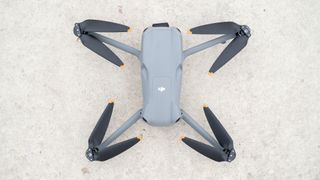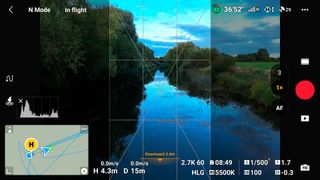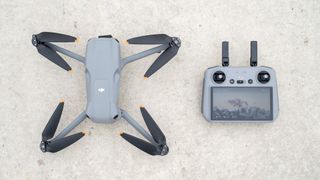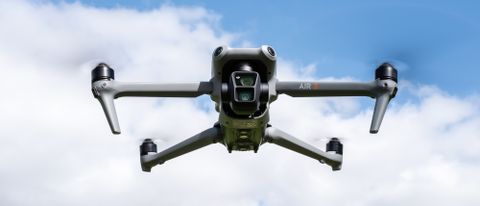Space Verdict
The DJI Air 3 delivers a highly capable flying and shooting experience that sits perfectly between the DJI Mini 3 Pro and DJI Mavic 3 models in terms of size, weight and power.
Pros
- +
Excellent dual cameras
- +
More powerful than the DJI Mini 3 Pro
- +
Omnidirectional obstacle avoidance
Cons
- -
Fixed aperture on both cameras
- -
Much bulkier than Mini 3 models
- -
Only around 7 oz/200 g lighter than Mavic 3 models
Why you can trust Space.com
Weight: 25.4 oz/720 g
Dimensions: Folded 8.1x3.9x3.6 in/207×100.5×91.1 mm/Unfolded 10.2x12.8x4.2 in/258.8×326×105.8 mm
Battery: 4241 mAh Li-ion/up to 46 minutes
Charger type: USB-C cable/AC Mains with chargers and hub (available separately)
Modes: Cine, Normal, Sport
Video transmission range: Up to 12.4 miles/20 km (FCC)/up to 6.2 miles/10 km (CE)
Video resolution: 4K, 1080p (FHD), 2.7K Vertical Shooting, FHD Vertical Shooting
Frame rates: 4K up to 100 fps, 1080p up to 200 fps, 2.7K Vertical Shooting up to 60 fps, FHD Vertical Shooting up to 60 fps
After what feels like a rather long wait, the DJI Air 3 is finally here and brings with it a couple of surprises alongside better-than-anticipated features and functionality. DJI Air models traditionally sit between the Mini and Mavic drones, and the Air 3 is an exciting blend of the two, making it one of the best drones available and one of the best camera drones on the market.
The Air 2S featured a 1-inch sensor with a fixed aperture, setting it apart from the Mavic 2 Pro, which was also available at the time of launch and featured a 1-inch sensor with an adjustable aperture in the camera. The Air 3, however, has taken a step back in sensor size, using the same excellent 1/1.3-inch sensor as the DJI Mini 3 Pro, with two of these sensors in the dual camera offering 24mm and 70mm equivalent focal lengths.
The only downside of the cameras for video capture overall is that the apertures are fixed. But since they use the same sensor, image quality, features and functionality are consistent across the two. The list of features on offer is impressive beyond the dual cameras, with omnidirectional obstacle avoidance, vertical 2.7K video capture, 4K slow motion video and 48MP photo capture, to name but a few.

Considering the range of features on offer, more of which we'll cover later, the Air 3 comes in at a fairly reasonable cost of $1099 / £962 for the DJI Air 3 (DJI RC-N2) kit, $1349 / £1199 for the DJI Air 3 Fly More Combo (DJI RC-N2) kit and $1549 / £1379 for the DJI Air 3 Fly More Combo (DJI RC 2) kit. The latter two kits include a smart controller, additional batteries, a carry bag and additional accessories.
DJI Air 3 review: Design




- Medium-size drone with folding design
- Long battery life
- Three controller options
The DJI Air 3 is unmistakably a DJI drone, with its dark-gray airframe and a folding design that takes it from a folded size of 8.1 x 3.9 x 3.6 in (207 × 100.5 × 91.1 mm) for storage and transportation to 10.2 x 12.8 x 4.2 in (258.8 × 326 × 105.8 mm) when unfolded for flight. It's certainly more compact than the Mavic 3 models, but at 25.4 oz (720 g) it's not that much lighter. This means that users living in the EU and some other non-EU European countries will see that the drone has a C1 rating.
Being much larger than the Mini 3 models, the Air 3 has a maximum wind resistance of 27 mph, and during testing with gusts just below this wind speed the drone didn’t miss a beat. Battery life has also been vastly upgraded, with a maximum advertised flight time of up to 46 minutes per 4241 mAh Intelligent Flight Battery in highly controlled wind-free conditions. During testing in warm and low wind conditions, flight times were averaging 35 minutes before Return to Home was suggested when the battery level reached 20%.



There are three controller options, including the DJI RC-N2 controller (which requires a smartphone since it has no built-in screen) and two smart controller options, with the more expensive of the two offering the most features. The two kits that come with smart controllers are also Fly More Bundles, which provide a range of useful accessories, including two additional batteries, a carry bag, a three-battery charging hub and more.
All three controllers provide direct access controls for accessing commonly used features, alongside flight controls for flying the drone and changing flight modes as required. The smart controllers undoubtedly offer the most convenience and speed up the set-up time, although the DJI RC-N2 controller works extremely well with Android and iOS smartphones running the DJI Fly app, making it a great option for those on a budget.
DJI Air 3 review: Functionality


- Omnidirectional Obstacle Sensing
- Smart Return to Home
- Multiple shooting modes
As you'd expect, the Air 3 flies exceptionally well and is so simple to use that beginners wouldn't feel out of their depth. Plus, more advanced pilots will enjoy the many camera and flight features that are on offer. As always, there are three flight modes: Cine, Normal and Sport. These provide different flight speeds for a variety of situations, while Cine also reduces control sensitivity for smoother flights and Sport mode switches off Obstacle Sensing.
Safety is a significant aspect of the Air 3, and several safety features make flights both more reliable and safer regardless of your drone flying experience. GPS positioning is a standard feature in DJI drones for maintaining position. During testing, while shooting a static hyperlapse in strong wind close to the Air 3's recommended limit, the drone held position commendably with only the odd bump visible in the resulting video.

Then there's the Omnidirectional Obstacle Sensing system that provides sensing in all directions to assist with collision avoidance, with APAS 5.0 available to assist with bypassing obstacles. This works exceptionally well and it does allow you to fly closer to obstacles such as trees with confidence, but you still have to take great care and can't solely rely on the feature to avoid collisions.
Return to Home (RTH) is another incredibly useful safety feature that returns the Air 3 to the take-off point autonomously when the Return to Home button on the controller is pressed or when the battery reaches a low level. Smart RTH utilises Omnidirectional Obstacle Sensing to plan and execute a fast and safe route back to the take-off point, with the ability to navigate and avoid obstacles along the way.
Another feature that takes advantage of the Omnidirectional Obstacle Sensing system is Focus Track, which can effectively track moving subjects even in complex environments, keeping the subject in the centre of the frame. Of course, even with such effective technology at work, you still have to carefully consider and plan how and where you can use Focus Track to maintain safe and legal flights and to minimize the likelihood of a collision.
Beyond the flight and safety features, there are plenty of shooting modes to keep even the most demanding photographers and videographers happy. There are Quickshots automated flight patterns for capturing professional-looking video with ease, 2.7K and 1080p Vertical Shooting for video, Mastershots, Hyperlapse, Slow Motion, Night Mode and multiple photography modes that allow you to take as much or as little control over the camera as you need.
DJI Air 3 review: Performance





- Dual 48MP 1/1.3-inch sensors
- 24 mm and 70 mm cameras
- Vertical video capture is available
Many people were speculating, and indeed hoping, that the Air 3 would include a simplified version of the Four Thirds Hasselblad camera featured on Mavic 3 models, but what was delivered was a bit different and arguably just as exciting. Rather than a single camera, the Air 3 offers two cameras, each using the same excellent 12MP/48MP 1/1.3-inch sensor used in the Mini 3 Pro and Mini 3 models. The main difference here is that one uses a 24 mm lens while the other offers a medium telephoto at 70 mm.
Perhaps one of the most useful aspects of using the same sensor type for the two cameras is that image quality, features and functionality are consistent, so you can switch between focal lengths while maintaining similar, if not identical results using both cameras. It's a smart move on DJI's part, and also leaves room for a potential Air 3S model with a fixed aperture Four Thirds Hasselblad camera in the future, which would follow the release pattern of the Air 2 and then Air 2S.



Speculation aside, both sensors also provide a 2.4μm pixel size which is great for low light shooting, alongside excellent ISO handling across the ISO 100-6400 range for 12MP photos and Normal color profile videos. The ISO range is, however, reduced to ISO 100-3200 for 48MP photos and ISO 100-1600 for D-Log M and HLG video. As the previous points suggest, the cameras can be set to capture photos at either 12MP or 48MP, although with the latter, functionality such as automatic exposure bracketing (AEB) and Pano etc. are unavailable.
Image quality across the two cameras is consistent, with the most sharpness in the main central area of the frame and a small amount of fall-off in sharpness at the edges. This certainly doesn't cause any issues in photos or videos, and the 24mm f/1.7 and 70mm f/2.8 lenses provide a huge amount of versatility so that most users will never need to take advantage of the digital zooms.


Photos can be captured in both Raw (DNG) and JPEG formats, while video can be captured in up to 4K in landscape format and up to 2.7K in portrait using in-camera cropping. 4K capture is available up to 100 fps, 1080p up to 200 fps, 2.7K Vertical Shooting up to 60 fps and FHD Vertical Shooting up to 60 fps.
The Vertical Shooting modes are designed for capturing videos specifically for social media, but this functionality unfortunately doesn't extend to photos. There are several video color profiles available, and in the Normal color profile, video can be captured in 8-bit H.264/H.265, while D-Log M and HLG (HDR) can be captured in 10-bit H.265. Both H.264 and H.265 formats offer a maximum bitrate of 150 Mbps. The gimbal can also be tilted between -90 degrees to 60 degrees, meaning that as well as the cameras being able to look straight down, they can almost be tilted enough to look straight up.
DJI Air 3 review: Cost


The DJI Air 3 not only sits between the DJI Mini 3 Pro and DJI Mavic 3 in terms of size, weight, features and functionality, but it also sits between the two price-wise. And although it's not a cheap drone, it's fair to say that it's reasonably priced for what you get, which is quite a lot.
The most basic kit includes the DJI RC-N2 controller, which requires a smartphone, along with one battery and costs $1099 / £962. If you'd prefer a smart controller with a built-in screen, the cheapest option is the DJI Air 3 Fly More Combo (DJI RC 2) which costs $1349 / £1199. The most advanced smart controller option is available in the DJI Air 3 Fly More Combo (DJI RC 2) kit which costs $1549 / £1379.
As well as the smart controller, the latter two kits also include two additional batteries, a three-battery charging hub, a carry bag and additional accessories. Only a Type-C to Type-C PD cable is included for charging, but there are two DJI chargers available separately and third-party USB chargers also work well with the hub and controller options.
Should you buy the DJI Air 3?

The Air 3 sits in a strange place in some respects, offering much more functionality than the Mini 3 Pro at a much larger size and weight, while being similar to the Mavic 3 in terms of features but without an adjustable aperture in the main camera. This makes it most suitable for those who need a drone with more power than the Mini models and a dual camera, but also for those who'd prefer something slightly smaller, lighter and less expensive than the Mavic 3 models.
It's a fantastic drone that produces excellent image quality for both photos and videos while providing the power you need to fly in windy conditions. The dual camera with 24mm and 70mm lenses also means that you can capture distant subjects with ease, as well as being able to capture subjects from a distance when you can't fly closer for safety and legal reasons.
If this product isn't for you
We've mentioned two other drone models several times already, so it's safe to say that if the DJI Air 3 isn't for you, then those would be your best alternatives. If you'd prefer a significantly smaller and lighter sub-250 g model, the DJI Mini 3 Pro is a fantastic option that uses the same sensor in its single camera as the Air 3 and is slightly cheaper.
If you'd prefer a more advanced and powerful model, and you have the budget, then the DJI Mavic 3 Classic with its single Four Thirds Hasselblad camera could be the way to go. But if you'd like the best consumer drone currently available, and one that offers a triple camera, the DJI Mavic 3 Pro is DJI's flagship consumer model with features and functionality aimed at professional use.
Join our Space Forums to keep talking space on the latest missions, night sky and more! And if you have a news tip, correction or comment, let us know at: community@space.com.
James is an award-winning freelance landscape and portrait photographer, as well as a highly experienced photography journalist working with some of the best photography magazines and websites with a worldwide audience. He’s also the author of The Digital Darkroom: The Definitive Guide to Photo Editing. www.jamesaphoto.co.uk

